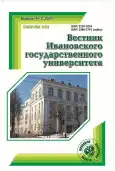Церемониальные функции преторианской гвардии в эпоху Принципата
- Авторы: Иванова Е.С.1
-
Учреждения:
- Нижегородский государственный университет им. Н.И. Лобачевского
- Выпуск: № 1 (2025)
- Страницы: 70-80
- Раздел: История
- URL: https://journal-vniispk.ru/2219-5254/article/view/310936
- DOI: https://doi.org/10.46726/H.2025.1.10
- ID: 310936
Цитировать
Полный текст
Аннотация
В статье исследуется проблема церемониальных функций преторианской гвардии и их значения для политической культуры Принципата. Рассматриваются визуальные проявления политической роли преторианцев в государственно-династических церемониях с целью проследить действие скрытых механизмов власти. Для достижения данной цели применяются подходы перформативного поворота,
в рамках которого церемонии и ритуалы изучаются как срежиссированные спектакли, организованные с политической целью для определенных адресатов. Автор приходит к выводу, что государственно-династические церемонии с участием гвардии имели важное значение для легитимации власти принцепса. Так, аккламации преторианцев во многих случаях выступали первичным институциональным ритуалом наделения кандидата в императоры верховной властью, а триумфы и adventus служили консенсусными ритуалами поддержки правящего режима и одобрения его политики. Ведущая роль преторианцев в этих церемониях показывает, что положение гвардейцев в иерархии императорского двора было сопоставимым по значению с влиянием сенаторского и всаднического сословий, и мнение гвардии оказывало значительное влияние на принятие политических решений.
Ключевые слова
Об авторах
Е. С. Иванова
Нижегородский государственный университет им. Н.И. Лобачевского
Автор, ответственный за переписку.
Email: ivelina777@yandex.ru
аспирант Нижний Новгород, Россия
Список литературы
- Великанова Е.Н. Initium принцепса: порядок передачи власти первым преемникам Августа // ВДИ. 2007. № 3. С. 163—174.
- Гуськов Е.А. Роспуск преторианской гвардии в 193 г. н. э. // Известия Самарского научного центра РАН. Исторические науки. 2024. Т. 6, № 1 (21). С. 120—129.
- Махлаюк А.В. Солдаты Римской империи. Традиции военной службы и воинская ментальность. СПб.: Филологический фак-т СПбГУ: Изд-во Акра, 2006. 440 с.
- Arena P. Imperator salutatus est. Rapporti tra salutationes imperatoriae e cerimonie da Caligola a Nerone, Il princeps romano: autocrate o magistrato? Fattori giuridici e fattori sociali del potere imperiale da Augusto a Commodo Commodo, a cura di J.-L. Ferrary, J. Scheid, Pavia, 2015, pp. 139—183.
- Balsdon J. The Emperor Gaius (Caligula), Oxford: Clarendon Press, 1934, 243 p.
- Benoist S. Rome, le prince et la Cité. Pouvoir imperial et cérémonies publiques (Ier siècle av. — début du IVe siècle apr. J.-C.), Paris: Presses Universitaires de France, 2005, 397 p.
- Bingham S. The Praetorian Guard. A History of Rome’s Elite Special Forces, London: I.B. Tauris, 2013, 240 p.
- De la Bédoyère G. Praetorian. The Rise and Fall of Rome’s Imperial Bodyguard, New Haven; London: Yale University Press, 2017, 336 p.
- Durry M. Les cohortes prétoriennes, Paris: E. de Boccard, 1938, 454 p.
- Flower H. Ancestor masks and aristocratic power in Roman culture, Oxford: Clarendon Press, 1996, 411 p.
- Gibson A.G.G. “All Things to All Men”: Claudius and the Politics of AD 41, The Julio-Claudian Succession: Reality and Perception of the “Augustan Model”, ed. by A. Gibson, Leiden; Boston: Brill, 2013, pp. 107—132.
- Kelly B. Violence and Security at Court, The Roman Emperor and his Court c. 30 BC—c. AD 300: vol. 1: Historical Essays, ed. by B. Kelly, A. Hug. Cambridge: Cambridge university press, 2022, pp. 371—394.
- Kerr J.L. The role and character of the praetorian guard and the praetorian prefecture until the accession of Vespasian: abstract of the dis. … Candidate of Sciences (History), Glasgow: University of Glasgow, 1991, 279 p.
- Kleijwegt M. Caligula's “Triumph” at Baiae, Mnemosyne, 1994, vol. 47, fasc. 5, pp. 652—671.
- Makhlaiuk A.V. Omnia deinde arbitrio militum acta: Political Initiative and Agency of the Army in Late-Republican and Early Imperial Rome, Leadership and Initiative in Late Republican and Early Imperial Rome, ed. by R. M. Frolov, C. Burden-Strevens, Leiden; Boston: Brill, 2022, pp. 457—488.
- McIntyre G. Making and Breaking Emperors: The cohors praetoria and the Transition of Imperial Power, Brill’s Companion to Bodyguards in the Ancient Mediterranean, Leiden, Boston: Brill, 2022, pp. 202—222.
- Ottley S. The Role Played by the Praetorian Guard in the Events of AD 69, as Described by Tacitus in his Historiae: abstract of the dis. … Candidate of Sciences (History), Perth: University of Western Australia, 2009, 273 p.
- Passerini A. Le coorti pretorie, Rome: Angelo Signorelli, 1939, 362 p.
- Price S. From noble funerals to divine cult: the consecration of Roman emperors, Rituals of Royalty: Power and Ceremonial in Traditional Societies, ed. by D. Cannadine, S. Price, Cambridge: Cambridge University Press, 1987, pp. 56—105.
- Rocco M. I pretoriani: soldati e cospiratori nel cuore di Roma, Rome: Salerno editrice, 2021, 200 p.
- Rollinger C. Changing the Guard: Guard Units and Roman State Ceremonial from the First to the Fourth Century, The Roman Imperial Court in the Principate and Late Antiquity, Oxford: Oxford University Press, 2023, pp. 56—74.
- Rollinger C. Specie Dominationis: The ‘Ceremonial’ Uses of Imperial Bodyguards under the Principate, Brill’s Companion to Bodyguards in the Ancient Mediterranean, Leiden; Boston: Brill, 2022, pp. 223—248.
- Smallwood E.M. Documents Illustrating the Principates of Gaius, Claudius and Nero, Cambridge: Cambridge university press, 1967, 147 p.
- Smith D.R. The DECVRSIO Sestertius Types of Nero and the Lusus Troiae, The Numismatic Chronicle, 2000, vol. 160, pp. 282—289.
- Wallace-Hadrill A. Civilis Princeps: Between Citizen and King, JRS, 1982, vol. 72, pp. 32—48.
Дополнительные файлы









